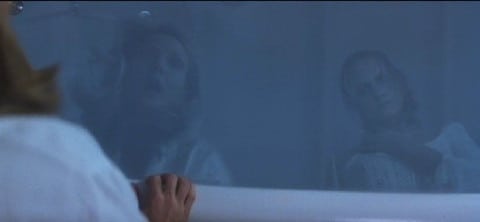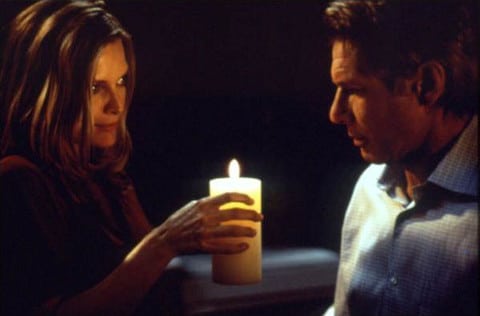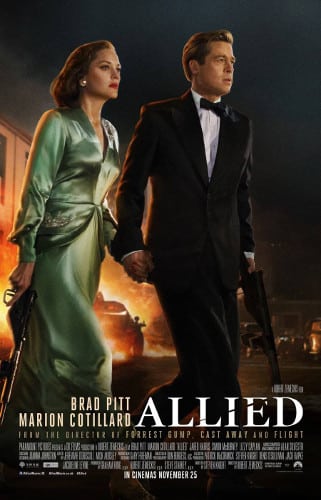What Lies Beneath (2000)
Directed by: Robert Zemeckis
Written by: Clark Gregg, Sarah Kernochan
Starring: Harrison Ford, Katharine Towne, Michelle Pfeiffer, Miranda Otto
USA
AVAILABLE ON DVD
RUNNING TIME: 130 min
REVIEWED BY: Dr Lenera, Official HCF Critic
Claire Spencer is living in Vermont with her husband, renowned scientist Dr. Norman Spencer. One year previously, Claire had been involved in a serious car accident that left gaps in her memory, and now that her daughter Caitlin is departing for college, she feels very vulnerable. The neighbours Warren and Mary Spencer keep arguing and when Claire overhears Mary sobbing, she becomes concerned. At night, she sees Warren dragging what looks like a body bag into the trunk of a car. With the help of her friend Jody, Claire begins spying on Warren, but then starts to witness strange occurrences when she is alone in the house and becomes convinced that Mary is dead and haunting her….
I used to be rather too keen to give away spoilers in my early days of reviewing for HCF. A sign of an inexperienced critic I suppose. For a new film, I do now try to avoid giving too much away if part of the potential enjoyment of a particular movie hinges on the twists its plot takes, but with older pictures that I would imagine most people reading the review will have seen, my initial approach really remains my one of choice. In the case of What Lies Beneath, not only did its trailer bizarrely give away far too much, but the way things are revealed play a major part in how well or not the whole film works. However, if you still haven’t seen Robert Zemeckis’ highly flawed but generally enjoyable ghost story, then I recommend that you skip paragraph five [the one just below the third picture] of this review. What Lies Beneath is often very well crafted technically, but less so in terms of its story, which is essentially a strong one but not too well told in the film, and not necessarily because the running time is far in excess of what you would expect from a film of this nature. I do have some admiration of a movie though which, eve in my third viewing and me knowing how the tale will pan out, still managed to chill rather successfully for some of its first half, with a few good BOO moments too. in fact the first hour of the picture is very good in general until things fall apart a bit afterwards, though Zemeckis’ handling of pure suspense sequences remains very impressive and I wish that he’d utilise his talent for this kind of thing again.
This film, which has nothing to do with the 2011 novel of the same title written by Sarah Rayne, began life as a treatment by documentary filmmaker Sarah Kernochan who encountered a ghost herself and adapted the event into a story about a retirement aged couple dealing with restless but compassionate spirits. DreamWorks then commissioned a full script from actor-writer Clark Gregg, which originally only had Claire and Norman just as boyfriend and girlfriend. It was delivered personally by Steven Spielberg himself to his friend Zemeckis, who had announced his interest in doing a thriller. Michelle Pfeiffer and Harrison Ford were Zemeckis’ first and only choices for the lead roles, while Zemeckis shot it while production on Cast Away was shut down so that Tom Hanks could lose weight for his character in that movie. What Lies Beneath was shot in Vermont, New York and Los Angeles where the main house depicted was only used for daytime scenes, night footage, for some reason, being done on a soundstage. The house was then torn down after filming because it didn’t meet local building codes. The controversial trailer [the decision to give away the identity of the ghost, and pretty much her murderer too, was truly baffling] features a good eerie moment not in the film in which Claire is looking at a photograph and notices a ghost face in the window. The film was a major hit at the box office, though doesn’t seem to be too well thought of these days.
So I said earlier that the first half is very good and it is really is almost a model of how to do this kind of thing well. There’s the odd amusing moment, notably a bit where our couple, wanting to physically reconnect now they’re alone in the house, hear the next door neighbours noisily ‘going at it’ and Claire finds it a turn on. It’s kind of sweet and the sort of thing you probably wouldn’t see if the film, which would probably only run for around an hour and a half, were made today. However, it’s really all about uneasy tension, and Zemeckis creates it brilliantly even before any supernatural presence begins to make itself known, with Claire convinced that something’s up with her neighbours and eventually becoming sure that the husband has killed the wife. The scene where she wakes up in the middle of the night and sees what could be a body bag being dragged into a car boot is splendidly atmospheric with its rain and thunder and bluish tinting, but the ghost stuff that starts to occur soon after is all the more effective because most of it happens in broad daylight. A dog barking at nothing, mysterious footprints, a ghostly face reflected in bath water – it’s all cliched stuff but hugely effective because of the time Zemeckis takes in creating the right uneasy feel and building up to the scare moments, the camera constantly prowling around the hugely spacious house. My one criticism is a common bugbear with me in films like this; the laziness of using a loud musical sting to create most of the effect of a scare when the scare itself should be enough. It’s fine if done sometimes, but not constantly.
We’re soon given the answer to one of the mysteries in the story, and I wish that perhaps the movie could have got the viewer to wonder if Claire was just ‘losing it’ a bit more. Instead, it gets rather silly, especially when Claire finds the identity of the ghost in a newspaper cutting concealed in the back of a photograph, which makes one wonder why on earth, if you’ve killed somebody, would you keep an article about her death? So the heroine can find it, of course, but it’s very lazy storytelling. And by this time I felt that the film had already basically told me that Norman wasn’t all that he seemed to be and, despite the script then wasting much time trying to convince us otherwise, it soon seemed obvious that he was the murderer. I can’t imagine anyone not working it out [even if they hadn’t seen the trailer], and the script needed to be far more subtle about it to all this to work. Of course it’s possible that Zemeckis and Clarke were doing the Alfred Hitchcock ‘suspense over surprise’ thing and meant for us to work it out, but I really doubt it considering that, for example, we begin to see some of the story from Norman’s point of view while Claire could be possessed which is an obvious attempt at misdirection. It means that the second half just doesn’t come off as well as it should despite Ford really being pretty good as a bad guy and a few really strong suspenseful sequences, the best one being when Claire is near to being drowned in a bath and is gradually coming to after being knocked out by chloroform. And it’s odd to have a climax where the villain is the one who sees a ghost, rather than the heroine, in moments which recall Ghost Story.
Even though the Master of Suspense never made a ghost story [unless you count Vertigo], the main influence does seem to be Hitchcock, what with Norman Bates looking through that peephole, and the dead Marion Crane falling out of the bath and pulling down the shower curtain, being very closely copied almost shot-for-shot, and Rear Window clearly referenced in the early section, though actually there seem to be more shots which borrow from Orson Welles rather than Hitchcock. While the film is quite slow paced, the direction from Zemeckis is livelier than normal and cinematographer Don Burgess was obviously encouraged to be a bit more stylised, with quite a few odd angles like the camera looking up from the floor at a body being dragged away. The CGI ghost effects aren’t too great but there aren’t many of them, and in fact it’s surprising how low key [despite a big car dashing climax] and even almost minimalist the film is with only one major setting, two major characters, and much time where we don’t really see anything happening at all.
Pfeiffer plays her part with considerable conviction and Ford avoids the faint air of ‘can’t really be bothered’ which affected most of his performances around that time. Alan Silvestri does the Bernard Herrmann pastiche thing with skill and allows his own musical style to come through. My overall feelings about What Lies Beneath can be basically summed up by me saying that it had the seeds and the ingredients of a real classic, and almost borders on being one during its first hour which is why I’ve still given the film a relatively high star rating, but needed some considerable reorganising before the cameras began to roll. It’s a good example of how the best technical skill can’t always compensate for the deficiencies of a script, but – make no mistake – there is still some considerable skill at work in this film….though I can’t but wondering if the best way to watch What Lies Beneath is to view the first half and then write the rest of the film in your head.











Be the first to comment